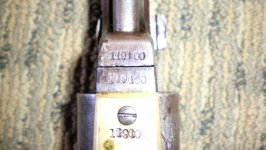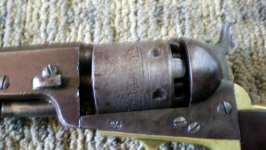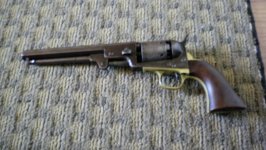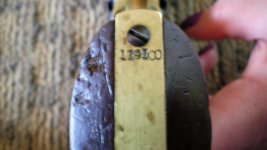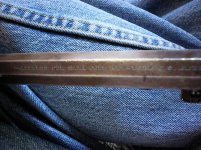My father has an 1851 colt navy revolver that has been in the family since the 1800's. It is in pretty decent shape. It does have an oddity with the serial number. The original no. appears to be 20,000, however stamped on top of that is 1191. I am attaching some pictures. Does anyone have an approximation of value, or at least info on what is up with the serial.
You are using an out of date browser. It may not display this or other websites correctly.
You should upgrade or use an alternative browser.
You should upgrade or use an alternative browser.
1851 colt navy
- Thread starter jedcris
- Start date
madcratebuilder
New member
The serial number re-strike is odd. No idea what that's about. I put the value around $1500+
Am including a picture of the but and barrel. Not sure what the wedge is and dont have the gun in front of me to look at the cllinder. Will check next time in at dads.
The serials appear to be
20000 under
II9I offset one space to the left on top
The serials appear to be
20000 under
II9I offset one space to the left on top
Attachments
I am a CW reenactor. This is a great piece but there are a few things that make it a suspicious of being an actual relic. I don't like the cylinder. the engravings are a highly detailed naval battle like the repros today. That would have cost a pretty penny and would have been done on special order. No private or sergeant, could afford such detailed engraving. As well as the cylinder looks to new and the bluing has worn down more then the rest of the gun. Revolvers then had the same problem now with cylinders. When it rotates, the hand that grabs the cylinder doesn't go down all the way and ends up scoring the cylinder all the way around, the grooves that catch the hand look fairly new, but the wear on the bluing of the rest of the gun shows that it has been in and out of a holster enough. As well as the butt of the grip looking like hell. it shows that it was used as a hammer. Why pack one when your gun works just as well. The rust pits on it look like it has seen some time in the elements. Leather holsters just cant do to good in protecting the weapon from rain and water.But on the other hand, the serial numbers are another thing. The old ones serial numbers under the new ones look to be good serial numbers. The top ones look fairly new compared to the weapon itself. it looks like someone attempted to make it a lower number model.The wedge screw looks to be worn but the others are in good condition. The only screw that you do not need to remove on the weapon for cleaning or dis assembly is the wedge screw.
there are a few things that make it a suspicious of being an actual relic. I don't like the cylinder. the engravings are a highly detailed naval battle like the repros today. That would have cost a pretty penny and would have been done on special order.
The engraving was standard on every Colt made.
Revolvers then had the same problem now with cylinders. When it rotates, the hand that grabs the cylinder doesn't go down all the way and ends up scoring the cylinder all the way around,
Then as now letting the hammer down from half cock and letting the cylinder turn until it locks is what scores the cylinder. If you pull the hammer back to full cock before lowering it you wont score the cylinder on an original or a modern repro.
Learn your parts. It's not the hand that scores the cylinder, it's the bolt.
mapsjanhere
New member
What would worry me about the condition is that the brass is in better shape than the steel part, and especially the mismatch between wood and brass condition at the butt end. Add the new looking screws in all brass parts, and I'd say it's a newer brass frame with old Colt body.
madcratebuilder
New member
I don't like the cylinder. the engravings are a highly detailed naval battle like the repros today. That would have cost a pretty penny and would have been done on special order.
As Mr Haggen said it is standard on Colt cap and ball revolvers. It's not really engraving, it's a W L Ormsby designed roll mark done by machine. There are some models without the roll mark on the cylinders, but few and far between. There are several different scenes depicted depending on the model of the revolver.
What would worry me about the condition is that the brass is in better shape than the steel part, and especially the mismatch between wood and brass condition at the butt end.
The brass grip frame and trigger guard has no finish to wear off like the steel parts do. When polished old brass looks as new. The wood grips shrink with age.
mapsjanhere
New member
The grips look, as remarked, like someone used the gun as a hammer. And they never hit the center brass section? And if you look at the transition between steel frame and brass trigger section in the second picture (82), there seem to be scratches and dents on the steel but none in the softer brass.
The grips look, as remarked, like someone used the gun as a hammer. And they never hit the center brass section? And if you look at the transition between steel frame and brass trigger section in the second picture (82), there seem to be scratches and dents on the steel but none in the softer brass.
I'm not seeing any of this. Grips used as a hammer look much worse than these. Wood dings more easily than brass and the brass does have a couple of dings showing. I'm not seeing dings in the steel, just discoloration. As for the screws, all the screws visible are in pretty decent shape other than the wedge screw. You're basing the condition of all the screws in the brass by the condition of the only one shown.
FWIW, the details of the barrel (thick lug and barrel marking) and loading lever catch are consistent with a gun in the 119xxx range, not with a gun in the 20xxx range. If the one marking is actually 20000, and the other 119100, I can't understand how the lower number would be the first (correct?) number as the gun is quite plainly not that early.
I can't explain what happened with the serial numbers, but I think the gun is genuine, not a reproduction or a fake, and that the number overstamp was done at the factory.
I can conjure up scenarios, but none really provide a logical answer.
Jim
I can't explain what happened with the serial numbers, but I think the gun is genuine, not a reproduction or a fake, and that the number overstamp was done at the factory.
I can conjure up scenarios, but none really provide a logical answer.
Jim
madcratebuilder
New member
Big Jim said:I can't explain what happened with the serial numbers, but I think the gun is genuine, not a reproduction or a fake, and that the number overstamp was done at the factory.
I agree 100%. The overstrike is very strange but appears to match the other fonts.
I don't know if this will help or not, but the "original" number, which I took to be 20000, looks like it would have been 120000. If it had been 20000, the numbers would not be centered, and I seem to see a lighter "1" under the heavier "1" of 1191. Further, there seems to be an attempt to preserve the last two digits "00", so the overstamp was not intended to create a "low number", it was intended to change only the first four digts.
But the question of why the restamping remains unanswered and may never be known.
Jim
But the question of why the restamping remains unanswered and may never be known.
Jim
I don't know how accurate the dating is for the period before the 1864 fire, but Wilson puts both 1191xx and 1200xx at 1862. If that was a military gun, it is possible that the government didn't care at that time about the serial number as long as the gun worked. Even so, it is a puzzle I would like to see solved.
A Colt letter might have some information, but it is a crapshoot. No guarantees.
Jim
A Colt letter might have some information, but it is a crapshoot. No guarantees.
Jim
Jim Watson
New member
Lessee, now.
The serial number was clearly restruck;
"And then it looks like the US marking has been oblilterated."
How often have we seen such things on Grandpa's pilfered 1911?
Could HIS Grandpa have been worried about taking his sidearm home, too?
The serial number was clearly restruck;
"And then it looks like the US marking has been oblilterated."
How often have we seen such things on Grandpa's pilfered 1911?
Could HIS Grandpa have been worried about taking his sidearm home, too?
I don't think so either, and a lot of CW vets did bring back issue weapons, but the rules were there, and troops mustering out did have to turn in their arms and ammunitiion. But right after the war, the government itself disposed of tons of now-obsolete weapons to surplus dealers and to foreign governments (France in particular) sometimes directly, some times through arms brokers. Just like today, weapons sales were used as instruments of foreign policy.
That gun is really a puzzle to me; every reasonable explanation seems to have a contradiction.
Jim
That gun is really a puzzle to me; every reasonable explanation seems to have a contradiction.
Jim

